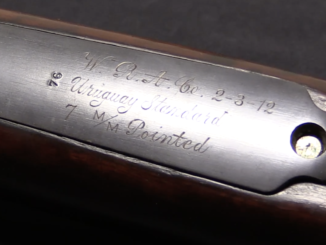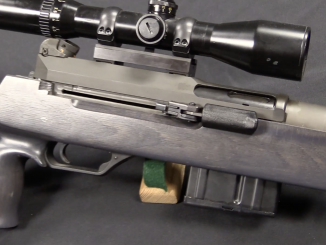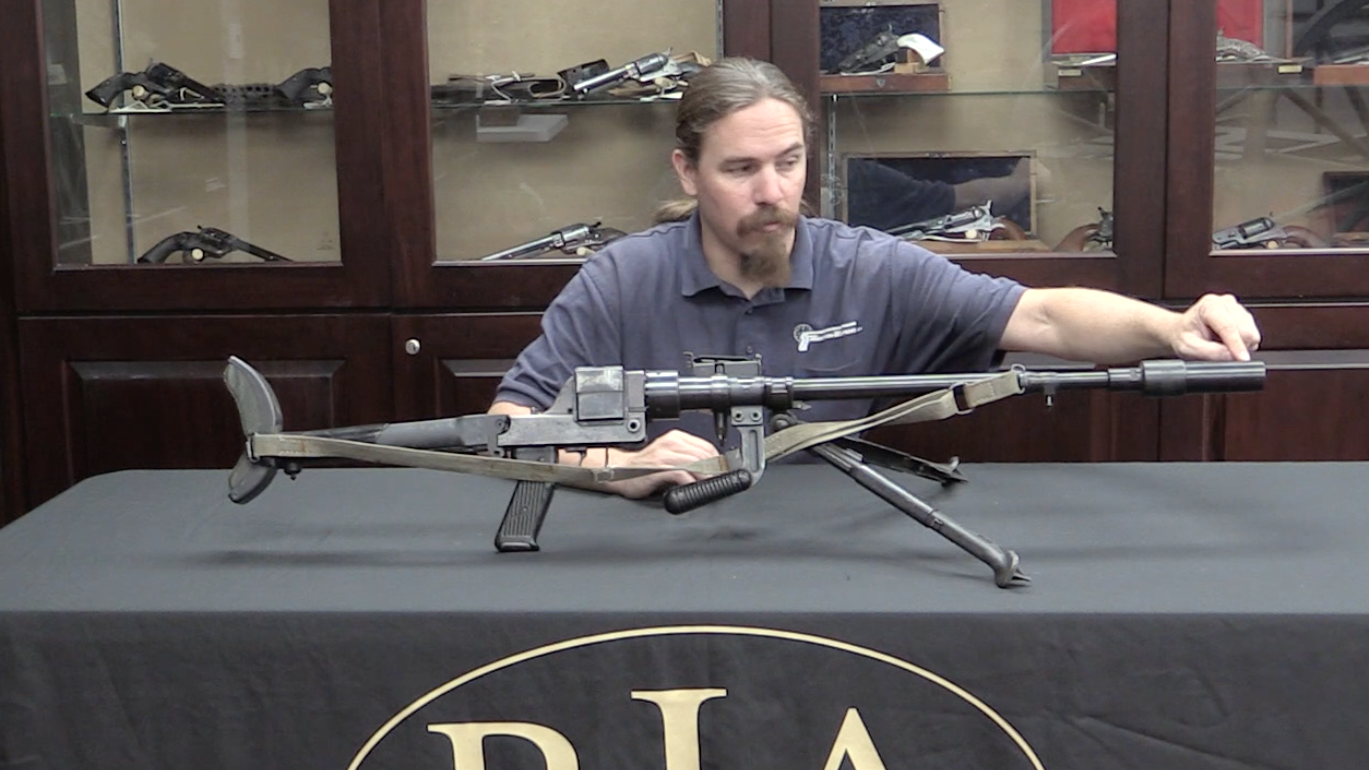Designed by Louis Schmeisser, the Dreyse Model 1910 was an attempt to build a blowback pistol in 9x19mm for German military or police service, expanding on the existing market for the popular smaller .32ACP (7.65mm) Dreyse pistols. In order to make a safe blowback action, Schmeisser made a very stiff recoil spring, which then required a mechanism for the shooter to disengage or bypass the spring in order to manually cycle the action.
The guns were excitedly received by several German agencies, and several thousand were ordered when the gun was announced. Unfortunately for Rheinische Metallwaaren- und Maschinenfabrik (the manufacturer), production turned out to be quite difficult, and only about 500 were actually produced before the plan collapsed.
Today we will take a look at two standard production examples and two prototypes…




With the given workmanship and precise machining, a simpler locked breech pistol could be made.
Just HOW simple? I’d imagine that Schmeisser would be required to redesign the ENTIRE ASSEMBLY (which inventor likes to deviate from his original ideas?) and come up with some locking mechanism NOT claimed by anyone else (and therefore get sued for patent infringement). Toggle lock was claimed by Luger and Borchardt… Locking flaps claimed by Mauser (C96 pistols)… Gas operation impractical (not enough gas)… Rotating bolt/barrel claimed by Karel Krnka, Fairfax, and some others… Tilting barrel claimed by John Moses Browning… Sliding locking blocks or tilting links combined with stationary barrels were probably not considered fit for pistol use despite being found in lever-action and slide-action long guns… Is there ANYTHING that wasn’t patented or claimed as parts of patents before? I’d like to see you answer THAT question. And don’t give me the “oh, you are such a boring unimaginative piece of crap” retort.
SAY SOMETHING!!!
Please do keep cool. If there is a will there is a way. Just think; What is the key part… The lever which connects the recoil sping to the breechbolt…
Could it be ussd as a lever to lock; the breechbolt as movably pinned over the barrel; Or as a lever to lock the barrel as pinned over the breechbolt… Both getting unlocked by camming recesses cut in the receiver in the location where current connecting lever mounted… Or… Could that lever be used as a lifter for breechbolt off line with barrel… Naming “Elevating bolt” instead of “Elevating Barrel”… All these layouts are in a plane over the barrel and bolt…Unusual place for those kind of parts for that era. Patents are limited by their claiming words. Inventions are made by inventors and patents are written by lawyers… They know what needs and to describe. Human mind has no limit. Just think…
Cheers
I have to agree – there are always ways how to do “the same” little differently. Some new ideas in pistols came as ‘late’ as in 1930s. The idea of slide blocking arm pivoting transversely around barrel axis while being controlled by recess/cam in (steel) frame is surely a plausible one. I conceptualised something along that line time ago.
Great that we can fiddle with ideas without responsibility. 🙂
So are we going to pivot/tilt the bolt just like that in the Colt-Browning M1895 machine gun? If so, then I suppose the sequence should be something like this:
1. Cartridge is fired
2. Barrel and slide begin rearward motion, bolt is locked to barrel
3. frame cam link or locking recess tilts the bolt and unlocks it
4. slide and bolt continue as barrel stops
5. extraction and ejection stage
6. return stroke locks the bolt to the barrel, new cartridge ready
Did I mess up?
Well described.
“Is there ANYTHING that wasn’t patented or claimed as parts of patents before?”
Question to German Patent Office.
“I’d like to see you answer THAT question”
Maybe short recoil/L-shaped locking element?
Maybe switch to decay there. You just spot out night 200 venomous words in response to an off hand remark
It shares some design features with the Jaeger pistol, particularly the bolt with a top strap over the barrel and recoil spring. A very simple way to manufacture a blow back pistol.
Also the F.L Langenhan automatic pistol in 7.65 x 17SR Browning;
http://www.pmulcahy.com/pistols/german_pistols_l-m.htm
It used a knurled thumbscrew to secure a “stirrup” linking the bolt to the recoil spring. With wear, the screw could back out during firing, allowing the bolt to depart the pistol with considerable velocity right into the shooter’s face.
It was used by the German police and as as substitute standard issue pistol for the Reichswehr during WW1. My guess is that personnel who it was issued to were not pleased.
cheers
eon
“attempt to build a blowback pistol in 9x19mm”
http://unblinkingeye.com/Guns/10-14M/10-14m.html states that Josef Nickl tried to make 9×19 mm blow-back automatic pistol, but without success. Can Schmeisser know about that attempts?
Contributing to the recoil spring bypass lever being jarred out of position is the design of the breech bolt and its forward weight. The weight raises the center of mass, so when round is fired it produces a torque on the recoiling assembly. This cause it to pitch down at the front and up at the rear. While good for recoil mitigation, the problem is when this pitching is stopped, inertia of the bypass lever tends to loosen it. One solution is make the lever lighter and latch it down tighter, which is what the prototype does. Another way but probably less effective would be to reduce the torque by lowering the center of mass of the recoiling parts so that it was inline with the bore axis. IMHO
Interesting side note; Rheinische Metallwaren und Maschinenfabrik became better known during WW2 by the name it adopted after a post-WW1 reorganization; Rheinmetall.
cheers
eon
Blowback 9mm? A bit later than this, but the Astra 400 and 600 😉
Also the original Walther MP-PP, basically a slightly oversized PP with a fairly heavy slide and a rather overpowered recoil spring around the fixed barrel;
https://www.forgottenweapons.com/walther-mp-pp-prototype-at-james-d-julia/
Besides 9 x 19mm, it was also made in 9 x 23mm in the hope of getting the Chilean Army to buy it.
cheers
eon
See also Балтиец:
https://ru.wikipedia.org/wiki/Балтиец_(пистолет)
it was blow-back automatic pistol for 7.62×25 cartridge, it was Walther-inspired (cf. photo in link), 14 were made in besieged Leningrad. It was mainly used as gift for high-ranked, see section Экземпляры.
“Blowback 9mm?”
Also during WW1 Walther Model 6 firing 9×19 mm was produced in limited numbers
http://historypistols.ru/blog/pistolety-pod-unitarnyj-patron-avtomaticheskie/pistolet-valter-model-6-walther-model-6/
basically it is up-scaled Walther Model 4 (7,65 mm Browning/.32 Auto)
Are these from the same collection as all the Bergmans you did a while ago? The background in the videos looks the same.
Some detaiiled info here; http://historypistols.ru/blog/pistolety-pod-unitarnyj-patron-avtomaticheskie/pistolet-drejze-kalibra-9-mm-dreyse-9mm-pistol/
Some detailed info here; http://historypistols.ru/blog/pistolety-pod-unitarnyj-patron-avtomaticheskie/pistolet-drejze-kalibra-9-mm-dreyse-9mm-pistol/
Thanks for the links Strongarm, very cool pistol.